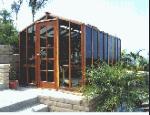Search engine visitors - click here to access entire "$ensible Home" web site
Click here to see a descriptive illustration of several designs of greenhouse kits and accessories.
Dear Jim: I want a small, relatively inexpensive do-it-yourself greenhouse kit for growing plants. I need an efficient one that does not require much expensive heat during the winter. What options do I have? - Barb A.

A: There are literally hundreds of models and sizes of do-it-yourself greenhouse kits ranging in cost from several hundred to several thousand dollars. Even the very inexpensive ones allow you to grow plants year-round and have a fresh salad or cut flowers during the winter.
In most climates, some additional heat will be required during the winter to grow plants year-round. The amount of heat required can be limited by building an attached greenhouse kit on the southern wall of your house.
Just opening a window from your house into the greenhouse may provide enough heat. If not, there are small greenhouse heaters (electric, gas or propane) available. The carbon dioxide from the unvented ones is good for plants. During fall and spring, the greenhouse may help heat your house.
The least expensive and easiest-to-build ones use steel tubing and plastic or steel snap-together joints. It takes about 30 minutes to snap the frame together and slip the flexible cover over it. The cover includes doors with zippers. If you wish, snap it apart and store it in its bag over the summer.
When selecting your greenhouse, the covering is an important factor. In moderate and cold climates consider a more expensive double-wall covering material that provides extra insulation. Double-wall polycarbonate is often used and is extremely durable. Since greenhouses are used for starting and growing plants, not for living space, a clear view of the outdoors is not important. Actually, a nonclear covering that diffuses the incoming sun's rays is better for the plants.
Another option is a double-wall corrugated acrylic plastic. It is made like corrugated cardboard without one of the skins. This allows it to easily be bent in an arch to cover a curved frame. For lower cost or in mild climates, single-wall fiberglass or reinforced polyfilm is a viable option.
There are many frame options including aluminum, steel, redwood, cypress, cedar, and frameless. Aluminum or steel frames are the strongest and least expensive, but the natural wood ones are most attractive. Frameless models use a strong fiberglass covering and are delivered completely built.
Your greenhouse will also need some type of ventilation. Some kits include vented roofs that open and close automatically as the temperature changes. Others have electric exhaust fan kits that operate from a wall thermostat.
Instant Download Update Bulletin No. 623 - buyer's guide of 17 do-it-yourself greenhouse kits, styles ( freestanding, lean-to, gazebo, circular), frame materials, warranties, features, covering/glazing materials, descriptions of glazing/coverings and the advantages of each type, illustrations and prices for several models, suggestions on choosing a site for your greenhouse, tips on installation.
Dear Jim: We are building a new house in a moderate climate. I have considered using an insulated permanent wood foundation. How can I tell if it is worthwhile to go to the additional expense of one? - Kim D.
A: Permanent wood foundations (all weather wood foundations) are basically a strong insulated wall made with pressure-treated lumber. Before you install one, have your soil type checked for proper drainage.
These foundations are excellent for houses with basements which are going to be used as heated and cooled living space. For uninsulated crawl spaces or unheated basements, their insulation is less of an energy advantage.